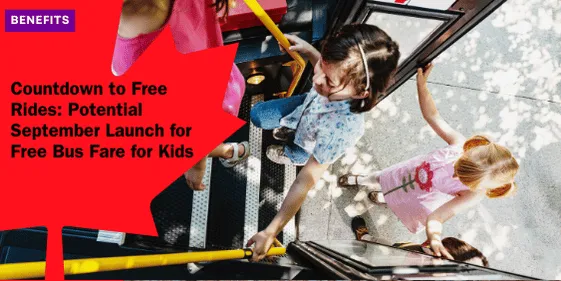Countdown to Free Rides: Potential September Launch for Free Bus Fare for Kids

Anúncios
Saskatoon City Council is poised to potentially launch a new initiative that could provide free bus fares for children in Grade 8 and under starting this September.
This progressive decision, scheduled for deliberation at Wednesday’s city council meeting, not only signals a commitment to improving transportation equity but also reflects a broader effort to support families in accessing essential services.
Anúncios
By removing financial barriers to public transit, the council aims to foster greater independence and mobility for young riders, ensuring they can participate more fully in school, recreational activities, and community events.
This move is part of Saskatoon’s ongoing efforts to build a more inclusive and accessible urban environment, promoting sustainable transportation solutions that benefit all residents.
Anúncios
Current Fare System Overview
Currently, Saskatoon’s public transit system offers free fare for children under the age of five.
For children between kindergarten and Grade 8, a fare of $2.25 is charged, while high school students pay $2.75 per ride.
This tiered fare structure has been a point of contention, prompting the city council to explore more equitable options.
The existing fare structure has been criticized for potentially excluding certain families with young children from accessing affordable transportation.
Critics argue that the varying fare rates create financial barriers, especially for families with multiple school-age children.
This discussion has highlighted the need for a more inclusive approach that supports broader access to public transit, aligning with the city’s goals of promoting sustainability and community mobility.
As Saskatoon Transit prepares to potentially implement free bus fares for children in Grade 8 and under, stakeholders anticipate positive impacts on family budgets and increased utilization of public transportation among young riders.
Decision Points and Recommendations
A recent report presented to the council outlined two critical decision points:
- ✅ Applicable Age for Free Fare: The report recommended extending free fare eligibility up to and including Grade 8, encompassing all elementary school-aged children.
- ✅ Verification Process: Several verification methods were proposed, including using a child pass or requiring children to be accompanied by an adult. However, city administration favored a simplified approach where children can self-verify their eligibility by informing the bus driver that they are a child.
Public Engagement and Feedback
Throughout the consultation process, the majority of stakeholders expressed support for a streamlined verification process. This feedback highlights a desire for simplicity and convenience, especially for those involved in the public transit system on a daily basis.
Stakeholders, including parents, teachers, and transit users, recognized the importance of making the verification process easier and more user-friendly.
Many emphasized that removing unnecessary barriers would encourage greater participation in the free fare program, benefiting the broader community and fostering positive relationships between transit services and riders.
Concerns were raised about potential barriers that formal verification methods, such as requiring ID checks, might create for children, especially younger ones who may not have formal identification.
For younger riders, this could present a logistical challenge that could discourage participation or create unnecessary delays. These concerns directly influenced the recommendation for self-verification during boarding.
By allowing children and their families to self-verify, the process becomes simpler, reducing the need for additional documentation and avoiding awkward moments or confusion for children.
This approach not only simplifies the process for young riders, reducing potential embarrassment or confusion, but also aligns with community feedback emphasizing accessibility and ease of use.
By listening to the concerns of the public, the Saskatoon City Council aims to ensure that the policy is practical, efficient, and inclusive for all, especially those who might otherwise struggle with formal verification methods.
This decision reflects a thoughtful consideration of the real-life challenges faced by families in using public transit.
By opting for self-verification, Saskatoon City Council acknowledges the importance of inclusivity and responsiveness to public opinion, ensuring that the initiative is both effective and well-received by the community it serves.
The willingness to adapt and refine policies based on public input demonstrates a forward-thinking approach to governance. This collaborative approach underscores the council’s commitment to transparent governance and citizen engagement, building trust and enhancing the legitimacy of the decision-making process.
By actively incorporating public feedback into policy decisions, the council demonstrates its dedication to shaping policies that directly impact residents’ daily lives and reflect the needs of the community.
The input from residents serves as a reminder that public policies must always take into account the diverse needs and concerns of the population, ultimately ensuring the success and sustainability of initiatives.
This emphasis on engagement allows the council to make informed decisions that resonate with the community.
Implementation and Promotion
Should the recommendations be approved at the upcoming council meeting, Saskatoon Transit plans to launch a robust advertising campaign to raise awareness about the new fare policy well ahead of its proposed September 1 rollout.
This campaign is designed not only to inform but also to engage residents, ensuring they are aware of the changes and how to take full advantage of the program.
The timeline provides ample opportunity for the community to understand the new fare structure and become familiar with the self-verification process before the changes go into effect.
This campaign aims to inform residents about the eligibility criteria (age range and potentially school enrollment for verification) and encourage families to take advantage of the free fare program.
A key focus will be on simplifying the message so that all age groups and demographic backgrounds can easily grasp the benefits and steps involved.
By clearly outlining the criteria, families will be empowered to make informed decisions about their transit usage, increasing the likelihood that the program will reach its full potential.
By leveraging various media channels including social media, local newspapers, partnerships with schools and community centers, and potentially even informational booths at bus stops, Saskatoon Transit intends to ensure widespread understanding and participation in the initiative.
The inclusion of multiple channels will allow the campaign to reach a broad audience and target specific groups, ensuring that no one is left behind.
Using these platforms helps to guarantee that information reaches those who may not have regular access to certain communication mediums.
Reaching diverse audiences through targeted messaging will be key to maximizing program utilization. The campaign will tailor its approach for different demographic groups, such as younger families, students, and senior citizens, to address their specific needs and encourage their participation.
These outreach efforts will also help alleviate any confusion regarding eligibility or the self-verification process. Effective promotion of the program is vital for ensuring that the free fare initiative is widely adopted and utilized.
Stay informed as Saskatoon prepares to implement and promote this exciting development in public transportation accessibility.
As the rollout date approaches, residents can expect a well-coordinated marketing push that encourages them to embrace the new policy and highlights the long-term benefits of increased transit accessibility for families.
Conclusion
The potential introduction of free bus fares for Grade 8 and under in Saskatoon represents a significant stride towards making public transportation more accessible for families with young children.
This initiative is designed not only to make commuting easier but also to reduce the financial burden on households, allowing families to allocate resources to other important needs.
The policy aligns with broader goals of enhancing urban mobility, fostering inclusivity, and ensuring that all residents, regardless of income, have access to reliable transportation options.
By simplifying the fare structure and promoting inclusivity through self-verification, the city aims to enhance mobility options and reduce transportation costs for families.
This will be particularly beneficial in a growing city where transportation costs can represent a significant portion of household budgets.
The self-verification approach ensures that families with younger children can travel with ease, without being burdened by formal ID checks, and ultimately supports greater participation in public transit.
This initiative not only supports families economically but also encourages the use of sustainable transport modes from an early age, fostering a culture of public transit use among youth.
By encouraging children to use public transportation, the city is planting the seeds for a future where more people choose transit over private car use, benefiting the environment and reducing traffic congestion.
The program will likely have a lasting impact, helping to shape the next generation’s transportation habits.
Stay tuned for updates following the council meeting as Saskatoon prepares for this anticipated transit policy change, which promises to positively impact community accessibility and transportation equity.
The city’s commitment to improving public transportation options for families represents a forward-thinking move towards ensuring that everyone in Saskatoon can enjoy equitable access to mobility.






